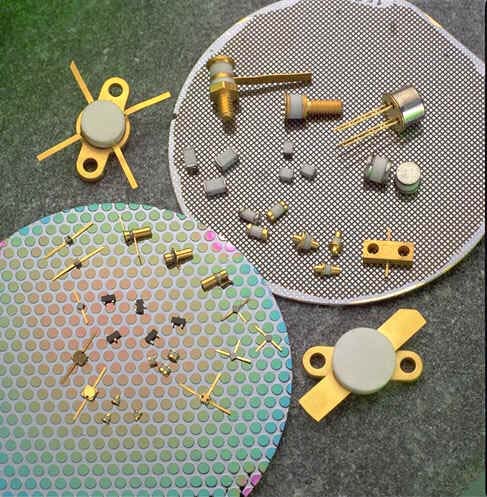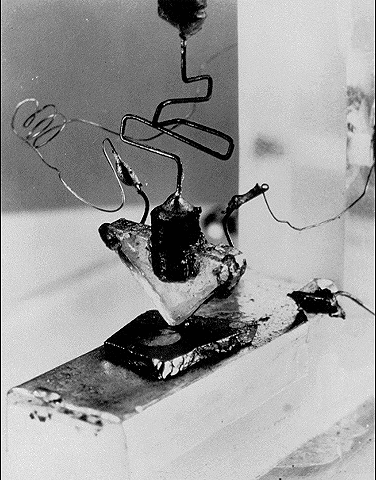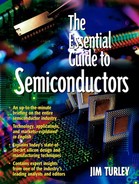Simple Analog Components
Discrete analog components tend to be physically small because they're fundamentally simple creations (see Figure 2.4). In the early days of electronics, all components were simple analog components. Since about 1960, engineers have been combining these discrete building blocks to create ever more elaborate, integrated components that tend to be physically larger.
Figure 2.4. These analog components, scattered across two silicon wafers, show the variety of shapes and sizes these components can take. Courtesy of Texas Instruments. Used with permission.

Some analog components are sold as small discrete components; others are combined into larger integrated analog components, seen later. Engineers designing analog products (e.g., radios and some stereo gear) sometimes like to fine-tune their designs by hand-picking each individual analog component. In contrast, engineers designing computers and other large digital products are happy to use ICs, taking their components in bulk. There's a fair amount of finesse required to design and build complex products from discrete analog components, and engineers gifted with that talent are rare and valuable.
Resistors, capacitors, diodes, and other common analog discrete components are smaller than a penny and cost even less. These analog components are like the insects of the semiconductor world: They are amazingly plentiful and almost totally ignored.
You might sometimes hear electronics aficionados discussing linear components, especially if they're into short-wave radios or high-end stereo gear. Linear components are a subclass of analog components. Some analog components are linear, and some are nonlinear. Linear describes how these components can take electricity and amplify (increase) or attenuate (decrease) it very smoothly without adding any “coloring” to it. In stereo gear, for example, it's important to play the music exactly as it was recorded without adding artificial distortion.
Resistors
Let's start our tour of the analog kingdom with resistors, probably the simplest and most common type of electrical component (see Figure 2.5). Resistors do pretty much what their name implies: They resist the passage of electricity. Resistors are electronic speed bumps, bleeding off voltage and slowing the electric flow.
Figure 2.5. Resistors are among the simplest electronic components. These three resistors are smaller than a pencil eraser and the wires on them are thinner than pencil lead. The colored stripes identify the amount of electrical resistance each resistor provides. Courtesy of Hitachi Semiconductor America. Used with permission.

Tech Talk
If you're a fan of Newton's Third Law of motion and Einstein's E = mc2, you know that energy can't be created or destroyed, only converted. Resistors convert the electricity they're resisting into heat; the bigger the value of the resistor, the warmer it gets. Tiny resistors like those you'd find in a portable radio generate so little heat it's not even noticeable. Some big resistors, though, need metal cooling fins to keep from overheating. In the extreme case, the whole purpose of a resistor is to generate heat. A car's rear-window defogger or burners on an electric range are both examples of resistors that get hot on purpose.
Although slowing down electric current seems pretty pointless, clever combinations of resistors can adjust voltages to specific and desirable levels. Technically speaking, resistors aren't really semiconductors because they're not made from silicon. Most resistors are just powdered carbon stuffed into a hollow tube, like a tiny pencil. Big, high-voltage resistors use coils of heavy wire in place of the carbon, making them essentially electric space heaters.
Resistors are so small that it's hard to print any markings on them, so they're identified with colored bands. The colors are a special code that electrical engineers memorize early in their careers. Each color stands for a different number, from nine to zero: black, brown, red, orange, yellow, green, blue, violet, gray, and white.
Capacitors
The next-most common type of analog component is capacitors (see Figure 2.6). Again, the name gives you a hint about its function. Capacitors store small amounts of electricity, like electric shoeboxes. Electricity flows in one end of a capacitor, where it gets stored indefinitely or until the capacitor “overflows.” The bigger the capacity of a capacitor, the more electricity it holds until it overflows.
Figure 2.6. Capacitors have just two wires, like resistors. The larger “can” capacitors contain rolled-up foil and plastic in layers. The smaller capacitor uses a small amount of insulating material to separate its two wires. Courtesy of Hitachi Semiconductor America. Used with permission.

Capacitors are simply two metal plates separated by a small gap. Electricity can't jump across this gap, so it builds up at one end of the capacitor. Finally, after enough electricity builds up on one side, the sheer force of all that juice pushes electricity away from the metal plate toward the other side. The net result is a brief time delay in the electric flow. If you're used to repairing cars, you might remember replacing the condenser, which is just another word for capacitor. The condenser is a big capacitor that stores enough electricity to create a spark in the spark plugs.
Capacitors, like resistors, aren't technically semiconductors because they aren't made from silicon. Capacitors usually include two metal plates separated by a piece of plastic, paper, or sometimes just air. To make the capacitors small and compact the plates are wound up into a cylinder like cinnamon rolls.
Inductors
Inductors are peculiar components that take advantage of magnetic fields to control the flow of electricity. They are basically coils of very fine wire looped around and around a tiny central core. The whole inductor might be only as big as a pencil eraser, but it contains yards and yards of wire. They're useful to engineers designing radio and cellular equipment, but inductors don't show up much in computers and other digital products. From the outside, inductors look much like capacitors.
Transistors
Transistors are a major step up the evolutionary ladder from resistors, capacitors, diodes, and inductors. They're also the first real semiconductor in our tour of the family tree. (Resistors, capacitors, and inductors are electronic components but they aren't made from semiconducting materials.) The invention of the transistor in 1947 was a landmark event in semiconductor physics. Transistors changed the way electronic systems are built and paved the way for everything from transistor radios to microprocessors.
Transistors were once called valves, which is a pretty fair description of what they do. A transistor, like a water valve or a spigot, has a place where current flows in, a place where it flows out, and some way to control the flow. Electrically speaking, transistors adjust the “water pressure” of a flowing electric current. They allow one electrical circuit to control another, like hands on valves. You'll find more discussion of how transistors work in Chapter 9, “Theory.”
Like a water valve, transistors can adjust the flow of electricity in variable amounts. This makes them analog components because they adjust electricity in a continuous stream. Also like a valve, transistors can turn the flow on or off completely, which would make them digital components. The fact is, they're both. Transistors bridge the gap between analog and digital. They can be used like analog components, smoothly adjusting electrical flow, or they can be used as digital components, acting as on/off switches.
Figure 2.7 shows the first transistor ever made. The electricity flows in through the curly wire on the left and flows out through the wire on the right. The thick wire in the middle controls the flow; it's the hand on the spigot. The triangular object attached to the wires is a chunk of semiconducting material. In this case, it's not silicon but a different natural material called germanium. After some experimentation, silicon was found to be a better material and virtually all semiconductors today are made from silicon.
Figure 2.7. The first semiconductor transistor, created in 1947 by John Bardeen, Walter Brattain, and William Shockley while working for Bell Laboratories. Courtesy of Lucent Technologies. Used with permission.

Tech Talk
Moore's Law—a comment made 40 years ago by one of the industry's early pioneers—has turned out to be a surprisingly accurate prediction of how fast the entire semiconductor industry races forward.
Fairchild Semiconductor's head of research and development, Gordon Moore, wrote an article in 1965 speculating that his company, and other electronic makers, would be able to squeeze twice as many transistors onto a silicon chip every year. Ten years later, in 1975, his prediction was right on the money. He reduced his estimate going forward, however, forecasting 18 months for each doubling. This became unofficially known as Moore's Law, and after 30 years, his prediction is still uncannily accurate.
Moore's Law is often misquoted or misunderstood. Moore said nothing about computer speed, microprocessors, or prices. He restricted his comments to packing transistors onto silicon. Happily, all the other benefits have come about because of the continual advances he projected.
Over the years a number of people, including Moore himself, have unsuccessfully predicted the end of Moore's Law. Despite many informed prophecies to the contrary, semiconductor progress continues at an astounding pace.
Transistors are still sold individually like resistors and other discrete components (see Figure 2.8). It's much more common, however, to see transistors grouped together, often by the millions, to create larger and more elaborate integrated components.
Figure 2.8. Transistors always have three wires, although the metal case is sometimes used as the third wire. Electricity flows in and out of a transistor, with the amount of flow controlled by the third wire. These transistors are each about the size of a pencil eraser. Courtesy of Hitachi Semiconductor America. Used with permission.

Transistors have more or less replaced vacuum tubes in radios and televisions. Like transistors, vacuum tubes used electricity to control the flow of electricity. Linking these together you could make elaborately interrelated electronic circuits. The problems with vacuum tubes were their large size, the frailty of their glass containers, the amount of electricity they used, and the heat they gave off. Transistors perform all the same functions without any of these drawbacks. Except for a few fanatical hi-fi stereo enthusiasts, nobody mourns the passing of vacuum tubes.
Strangely, transistors lead us into the world of digital electronics. This is strange because transistors are analog devices just like resistors or diodes. Electricity passes through them in smoothly varying amounts, like water through a spigot that's being gradually opened. Yet transistors' ability to turn the electric flow on and off—like shutting off the spigot completely—opened the door to a new kind of electronics and a new way of thinking. Digital electronics owes its existence to transistors and to the many different and unexpected things transistors can do when they're used in large numbers.
Diodes
Diodes make one-way streets for electricity. Electricity can flow through a diode in one direction but not the other. This makes diodes good for controlling the flow of electricity, directing it to where it's needed. From the outside, diodes look very much like resistors but without the colored bands.
LEDs
There's a special kind of diode that gives off light, so it's called, obviously enough, a light-emitting diode (LED), shown in Figure 2.9. Although LEDs work just like normal diodes do, they're more interesting for their lighting ability than for their one-way electrical characteristics. When electricity tries to pass through an LED in the “wrong” direction, it is stopped, just like a normal diode. However, when electricity passes through in the right direction, the LED glows. (For you physicists, the energy of the electricity is converted to visible light.)
Figure 2.9. This collection of LEDs includes samples of many colors. Each has two wires and a plastic lens. The color of the light it gives off depends on the combination of chemicals used to make the LED; the lenses themselves are usually clear. Courtesy of Hitachi Semiconductor America. Used with permission.

LEDs come in a few different colors, but red is the most common by far. Most home electronics, like your VCR, microwave oven, television, or bedside clock probably use red LEDs. They glow red simply because the chemicals used to make LEDs happen to give off that color; it was not an intentional choice.
Tech Talk
You might see clear or “white” LEDs from time to time. These are actually special red LEDs that have a color-filtering lens that blocks the red light, like tiny sunglasses. Filtering out colors like that is inefficient, so clear LEDs waste more electricity than colored LEDs.
Researchers have tried to make blue LEDs for a long time, with little success until recently. Why the big deal over one color? The combination of red, green, and blue LEDs would allow manufacturers to make LED television sets and dispense with big, heavy, expensive glass picture tubes. The combination of red, green, and blue (RGB) lights can create any color the eye can see. Without blue, LED TV wouldn't be worth watching.
With different chemicals inside, LEDs can be made to glow in different colors. Yellow and green LEDs are popular, but blue LEDs are exceedingly rare and expensive. It's hard to find a natural substance that makes good diodes that can also give off light. There are infrared LEDs that glow in colors you can't see. These LEDs glow in “invisible light” in the infrared spectrum. The remote control for your TV probably uses one of these. Press a button on your remote control; do you see any lights blinking on the front? Probably not, because the LED in your remote emits a color of light your eye can't see but your television can.
Tech Talk
If you have a video camera or camcorder, try videotaping yourself as you operate the remote control for your TV. Even though you can't see the light coming out of the infrared LED in the remote control, your video camera probably can. Play back the tape to see your remote blinking its secret signals to your television. Other remote controls (for your VCR, etc.) probably work the same way.
LEDs are now being used in car taillights, brake lamps, and city traffic lights because they're smaller and more rugged than light bulbs. One or two LEDs in a cluster can burn out, but the traffic light will still work. LEDs also light up faster than bulbs do. Some sharp-eyed people report seeing traffic signals “flash” when they turn red because LEDs don't warm up the way traditional bulbs do.
Laser Diodes
At the extreme end of the LED family tree are laser diodes, which are tiny lasers, no bigger than a pencil eraser. We've all seen laser diodes used as high-tech pointers in business presentations—they're a kind of nerd chic—but they're also common in the home. Every stereo CD player, DVD movie player, portable CD player, in-dash car CD player, and CD-ROM drive or DVD-ROM in a computer uses a laser diode. Most home video game systems use one, too. These little components have enabled a whole wave of consumer electronics and toys. Who would've thought that lasers, the preferred weapon of James Bond villains, would become ubiquitous, harmless children's toys?
Laser diodes are different from simple LEDs because they give off a narrow beam of laser light instead of glowing in all directions. Laser light travels in a straight line and doesn't spread out. That's why laser pointers make a small red spot on the wall instead of lighting up the entire room the way a light bulb would. That's also why you can't see a laser unless it's pointed directly at you, as opposed to an LED that's visible from anywhere. Creating a laser requires some precision manufacturing, so laser diodes are more expensive than LEDs. The tight beam of a laser diode is just what you want for reading the tiny marks engraved on a music CD or DVD.
Optical Sensors
Optical sensors are like the reverse of LEDs. Instead of giving off light, they detect light. These look like LEDs on the outside put perform the opposite task. Your TV remote control will have an LED on it, but your TV will have an optical sensor somewhere on the front to detect the light given off by the LED.
Optical sensors can't really see or recognize images. They can only tell whether the light nearby is bright or dim. If the light flickers, they can tell that, too. That's how TV remote controls work: by blinking their light off and on in various patterns like an invisible version of Morse code.
